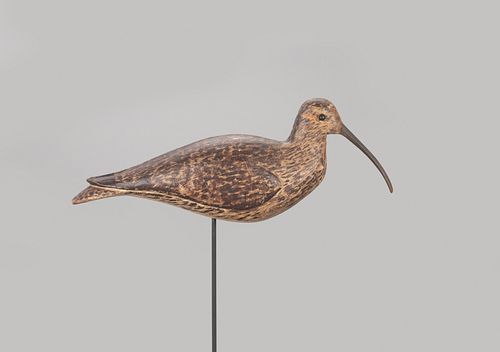Rare Curlew Decoy, Charles Sumner Bunn (1865-1952)
Lot 474
About Seller
Copley Fine Art Auctions
20 Winter Street
Pembroke, MA 02359
United States
Founded in 2005, Copley Fine Art Auctions is a boutique auction house specializing in antique decoys and American, sporting, and wildlife paintings. Over the course of the last two decades, the firm has set auction records for not only individual decoy makers, but also entire carving regions. Copley...Read more
Categories
Estimate:
$60,000 - $90,000
Absentee vs Live bid
Two ways to bid:
- Leave a max absentee bid and the platform will bid on your behalf up to your maximum bid during the live auction.
- Bid live during the auction and your bids will be submitted real-time to the auctioneer.
Bid Increments
| Price | Bid Increment |
|---|---|
| $0 | $50 |
| $1,000 | $100 |
| $2,500 | $250 |
| $5,000 | $500 |
| $10,000 | $1,000 |
| $25,000 | $2,500 |
| $50,000 | $5,000 |
About Auction
By Copley Fine Art Auctions
Jul 15, 2022
Set Reminder
2022-07-15 10:00:00
2022-07-15 10:00:00
America/New_York
Bidsquare
Bidsquare : The Sporting Sale 2022, Day 2
https://www.bidsquare.com/auctions/copley/the-sporting-sale-2022-day-2-9461
Lots 333-676 Copley Fine Art Auctions cinnie@copleyart.com
Lots 333-676 Copley Fine Art Auctions cinnie@copleyart.com
- Lot Description
Rare Curlew
Charles Sumner Bunn (1865-1952)
Shinnecock, NY, c. 1900
18 in. long
In 1971 Milton Weiler’s “Classic Shorebird Decoys” portfolio was published with text by William J. Mackey Jr. Across from Weiler’s Plate No. 3, illustrating a closely related curlew, Mackey writes, “In hand [the maker's] decoys have the feel of real birds. His knowledge and study of the live bird and his skill with a knife transferred the feel of the wishbone, the unfolded wings and the modeling of the bone structure to blocks of wood. His was a unique talent not given to any other decoy maker.” Mackey also states, “Nothing finer has been found ever since.”
This newly discovered and exceptionally rare Long Island shorebird now joins a small and elite group of curlew by this celebrated carver and guide. It has been passed down through a prominent New York family who lived in the city and escaped to Long Island and specifically the Hamptons. The family had a strong sporting heritage dating back to at least the 19th century and played host to figures including Ogden M. Plesissner. This decoy was retired from gunning to be displayed in their Upper East Side apartment. The bird is now making its debut to the decoy community, marking one of the greatest shorebird decoy discoveries in recent memory.
Very few decoys of this coveted model have surfaced, with fewer still held in private collections. One example from the William J. Mackey Collection was acquired by Dr. James McCleery in the 1970s, setting a record price for any decoy at the time. After that bird traded again in the McCleery auction decades later, it rejoined the ranks of the top decoys ever sold. The second and last known comparable in private hands, recently reached the market from the estate of Dr. Lloyd Griffith. Condition reports provided for the two aforementioned private collection examples suggest all three have survived in fairly comparable condition.
Lastly two related examples from the rig of T.F. Norton have been held in the Long Island Museum at Stony Brook since they were gifted in 1966. One of these two appears to be the model for Weiler’s illustration. This survey makes this lot the fifth of this model to surface publicly, and only third to come to auction.
The grand body is larger than some waterfowl and accordingly was made with two piece construction, held together by wooden pegs. "The shorebirds are ‘sui generis,’” writes historian and curator Bob Shaw, “carved to suggest nuances of body forms and underlying bone and muscle that no other carver even attempted.” Regarding his best works, Shaw states, “[They] transcend the decoy genre to rank among the finest bird portraits created by an American artist.”
Original paint with even gunning wear and some flaking mostly to front. Head has touch-up to neck crack and back of head and replaced bill. Shallow flat area around stick hole has been restored.
Provenance: Private Collection, by descent in a prominent New York City family
Literature: Robert Shaw, "Bird Decoys of North America," New York, NY, 2010, pp. 180-181, related example illustrated. Robert Shaw, "Call to the Sky: The Decoy Collection of James M. McCleery, M.D.," Houston, TX, 1992, back cover and pp. 36-37, related example illustrated. Milton C. Weiler and William J. Mackey, Jr., "Classic Shorebird Decoys: A Portfolio of Paintings," New York, NY, 1971, pl. 3, related example illustrated and discussed. Timothy Sieger, "The Decoys of Long Island," Water Mills, NY, 2010, front dust-jacket cover, frontispiece, and pp. 38-39, related example illustrated. E. Jane Townsend, “Gunners Paradise: Wildfowling and Decoys on Long Island”, Stony Brook, NY, 1979, p. 106, Norton rig pair illustrated. Sotheby's and Guyette and Schmidt, "American Waterfowl Decoys: The Distinguished Collection of Dr. James M. McCleery," New York, NY, January 22–23, 2000, lot 207, related example illustrated. Quintina Colio, "American Decoys," Ephrata, PA, 1972, p. 69, related examples illustrated (image reversed).Please email condition report requests to colin@copleyart.com. Any condition statement given is a courtesy to customers, Copley will not be held responsible for any errors or omissions. The absence of a condition statement does not imply that the lot is in perfect condition.Condition
- Shipping Info
-
Shipping info
Copley does not offer in-house packing or shipping. For clients who require shipping, please complete the Shipping Release Form and return it with your payment. The form includes a list of shippers we frequently work with.
-
- Buyer's Premium



 EUR
EUR CAD
CAD AUD
AUD GBP
GBP MXN
MXN HKD
HKD CNY
CNY MYR
MYR SEK
SEK SGD
SGD CHF
CHF THB
THB















